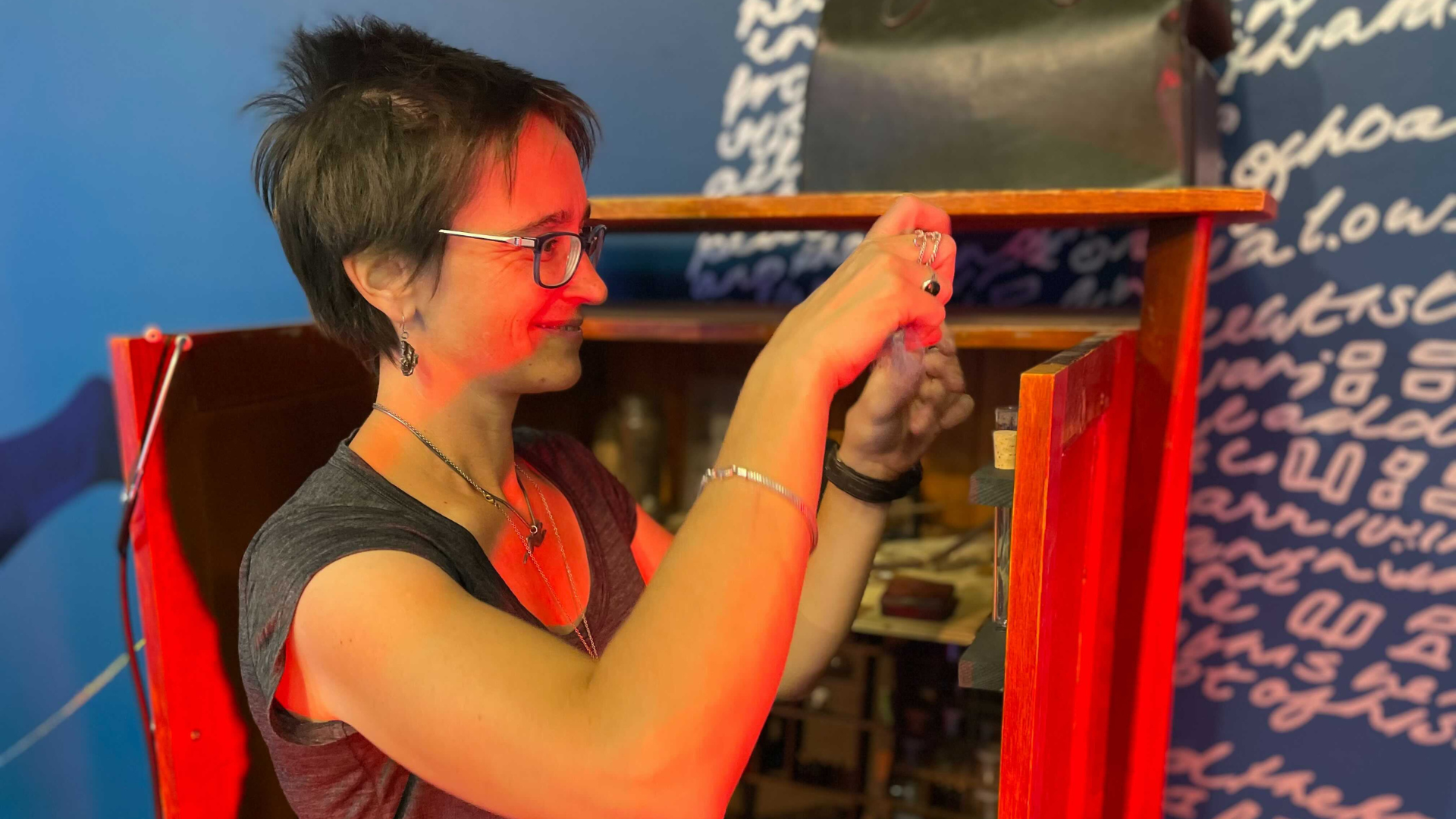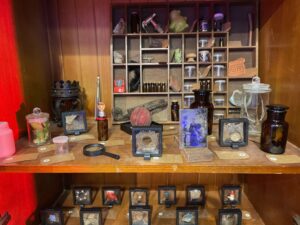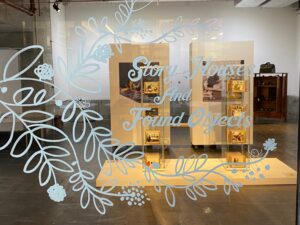Children’s book author Zana Fraillon brings objects to life through the power of imagination. In Story Houses and Found Objects, a joint exhibition with illustrator Anna Walker, participants comb through discarded items with new eyes, gaining an appreciation for their myriad possible futures in the process.

How long have you been making your Musem of Lost Things?
I’ve been collecting lost objects for about two years now – what’s at No Vacancy certainly isn’t all of them! I’ve always been fascinated by Cabinets of Curiosities. I love how they question the ideas behind museums and curatorship and ask who decides which objects are important enough to call history, and who decides which objects should be saved and displayed.
If museums are collections that are too important to be lost to time, then it begs the question, what is too important for each of us to lose to time? What is it that we cannot bear to be lost to the future? When I rediscovered this old cupboard in the back of our garage, it struck me that it would make the perfect home for the objects I had been collecting.
Where do you source the forgotten or discarded objects from?
Almost all of them were found washed up along the banks of the river near where we live, or beachcombing along Elwood and Brighton. I must confess that I did purchase one of the objects – the teeth – but these were inspired by the pit of teeth uncovered under Melbourne in the Metro Tunnel Dig. That image really stuck with me, so I wanted to find a way of getting at least a part of a pit of teeth into the museum. And as no one was keen to lose their teeth for me to find, I succumbed to purchasing them online. (And no, mine are not real teeth…) Oh – and I also purchased the prosthetic tongue. How could I go past a tongue?! I love watching people pick up the cloudy jar with the tongue, trying to work out what it could be inside. That moment of realisation is priceless.
What has been the most surprising response from participants in the Story Houses and Found Objects workshops?
People’s faces when they first see the cabinet! Adults and young people alike stop and gape for a moment, just taking it in. There is such magic in the cabinet, and this carries through into the exhibition. I love the way that the participants have allowed themselves to so readily believe in and engage with the fantastical elements of the display, and how they accept the origin story without question.
What I have loved the most though, is how the participants – of all ages – have taken the magic so seriously. Whether it’s listening to the stories the objects are telling them, writing letters for future generations that won’t be opened for 500 years – no one has taken the activities lightly. Perhaps the most surprising response though, is how much respect each object is given. Even the most everyday objects – old bottles, a plastic rubber duck – are all treated with reverence. It is very moving.

What do you hope for participants to get out of this process?
The hope has always been to open up a creative imaginative space for the participants, a space in which they are encouraged to imagine and explore possibilities without any expected outcome or product. Every activity asks participants to write or draw something in response to the object, but most of these are placed in the exhibit somewhere it is impossible for others to read. Memories are scrunched up inside memory jars, letters are posted into a locked suitcase, and while others are displayed and visible, it is up to the participants to decide what people can read and whether they are displayed or not. All the memories are anonymous. It is about the wonderfully powerful and enabling process of imagining, of bringing stories and possibilities into existence, not about the act of writing.
I also wanted participants to be invited to see the world differently. To imagine the multitude of voices and stories contained inside everyday objects, and to imagine both the pasts and the myriad possible futures for the objects. Above all, I wanted the exhibition to encourage visitors to imagine themselves as stories carried by objects, to switch the narrative and see us entering the biographies of objects instead of the other way around. We enter into the object’s stories and leave a little bit of ourselves inside them to carry into the future.
Perhaps most importantly, I wanted the participants to be enabled to see themselves as the future ancestors we all are. What stories will our fossils tell? What kind of ancestor will we be? If we can imagine the past stories contained in objects, then we are better enabled to imagine the future stories and possibilities that exist for all of us. Anything becomes possible.
What has it been like working alongside Anna Walker and her story houses? Has it changed the way you view your Musuem of Lost Things?
It has been an absolute delight working with Anna! She is such an incredible artist and writer, and simply being around her is wondrously generative. We have had many conversations that would explode into ideas of what we could do, or how we could display something, or what future projects could become.
Her Story Boxes are everything I love – small moments captured in time, that talk of a bigger story waiting at the edges. They certainly help me to envision possible stories for the objects in the Cabinet, and I’m sure they do the same to participants. I hope that by having the Museum of Lost Things alongside Anna’s story boxes, participants are better enabled to imagine the small moments captured in everyday objects and can see the stories that bloom from each. The two exhibits are really two sides of the same coin.

I guess for me the question is, what is it that turns any object into something magic and worthy of storytelling? What makes an object in a museum more important than an object dug up in the back garden or washed up on the shore of a beach? I have always loved the notion that objects are containers for stories, and that a small shadow of each person remains in the object long after the person has gone.
Objects are the voices of our ancestors – both human and more than human – speaking to us through time. What are they telling us? I think it is easy for many of us, living in the capitalist, consumerist society that we do, to forget that objects exist in Deep Time – the plastic bottle floating along the gutter outside your house started its life 145 million years ago as a phytoplankton bloom. After transforming into oil over millions of years, it was then extracted from the earth, heated, cooled, distilled, cracked apart, recombined, chopped into pellets, moulded into a bottle, used once, and discarded. But that bottle, and the stories collected and contained in that bottle, will continue to exist for millions of years into the future as well. We enter its story in the middle of its life and are just one of the billions of fleeting encounters that bottle will have. As it washes into the storm water drain and out to sea, it will become home to algae and bacteria, fish will nibble at it, a mother bird will swallow its cracked lid to feed to her chicks, it will be hauled into nets and onto ships, wash up on a deserted island where a lost and desperate woman will entrust it with a hand scrawled cry for help, it will be stuck under mudslides and trapped in ice, it in turn will trap a young turtle who entered but is unable to find her way out, it will become a home for mollusks and barnacles, and eventually, will wash up on the shore of the rubbled remnants of what used to be a bustling city.
Here, thousands of years since it passed by your house, the plastic bottle will be slowly broken and fragmented into smaller and smaller pieces of plastic, each one that will continue to exist in the bloated stomachs of birds and whales, seals and dolphins, octopus and turtles, and will soon become a geological layer in the earth. That plastic bottle, floating along the gutter outside your house, holds a genii. All you have to do is listen to it.
As part of our Wheeler Kids program, Anna Walker and Zana Fraillon are leading two workshops at No Vacancy Gallery on Saturday, 11 June 2022. Follow the links to find out more and to book the morning and afternoon workshops.
Related Posts

Read
Anne-Marie Te Whiu Receives The Next Chapter Alumni Poetry Fellowship
2 Apr 2024

Read
What's on in April: Resident Organisation Round Up
28 Mar 2024

Read
Blak & Bright First Nations Literary Festival returns in 2024
7 Mar 2024

Read
What's on in March: Resident Organisation Round Up
29 Feb 2024

Read
Hot Desk Extract: International
23 Feb 2024

Read
Hot Desk Extract: The Rooms
23 Feb 2024
Share this content